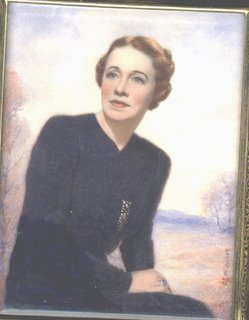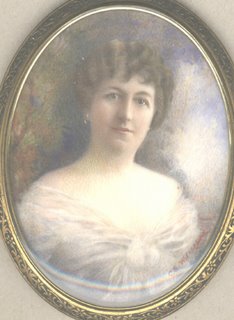
 These two miniatures were acquired together and are both believed to be portraits of the American actress Lillian Russell (1861-1922).
These two miniatures were acquired together and are both believed to be portraits of the American actress Lillian Russell (1861-1922).She became one of the most famous actresses and singers of the late 19th century and early 20th century, known for her beauty and style, as well as for her voice and stage presence.
Russell was born in Iowa but raised in Chicago. Her parents separated when she was eighteen, and she moved to New York with her mother. She quickly began to perform professionally, singing for Tony Pastor and playing roles in comic opera, including Gilbert and Sullivan works. She married composer Edward Solomon in 1884 and created roles in several of his operas in London, but in 1886 he was arrested for bigamy. Russell was married four times, but her longest relationship was with Diamond Jim Brady, who supported her extravagant lifestyle for four decades.
In 1885, Russell returned to New York and continued to star in operetta and musical theatre. For many years, she was the foremost singer of operettas in America, performing continuously through the end of the nineteenth century. In 1899, she joined the Weber and Fields's Music Hall, where she starred for five years. After 1904, she began to have vocal difficulties and switched to dramatic roles. She later returned to musical roles in vaudeville, however, finally retiring from performing around 1919. In later years, Russell wrote a newspaper column, advocated women's suffrage and was a popular lecturer.


Although the miniatures have no identifying inscription, a previous owner had purchased them as being of Lillian Russell. There are various known photographic portraits which are similar and thus support the identification. They include the examples showing here.
The miniature with the older sitter is less certainly of Lillian Russell, but their shared provenance, the apparent date of painting, a similar curl in the middle of her forehead, and the predilection towards the wearing of pearls all support an identification as Lillian Russell.
One of the two artists is unknown, but the other portrait is signed C S Wiltschek, for Charles Sigfried Wiltschek. He was an art dealer in New York, but he also painted many miniatures, usually over a faint photographic base, as was common in early 20C America.



Other examples in this collection are: Wiltschek, C S - portraits of 20C ladies
Wiltschek, C S - portrait of 1930's lady
There is little in the reference books about the artist, although there is a reference to a crippled artist in the 1930's called Charles Wiltschek who is believed to be the same person, possibly with the full name Charles Sigfried Wiltschek. In his WWI draft registration card Sigfried Wiltschek stated that he had "one leg shorter than the other" and described himself as an art dealer. Sigfried Wiltschek lived in New York in 1920 with his wife Mollie, his two sisters, Violet and Jospehine, and his brother, William. Sigfried described himself as an artist in the 1920 census records. He was born in Austria in 5 Aug 1876 and arrived in the United States in 1898, where he was naturalised in 1907. C. S. Wiltschek, painted several portraits of the Duke family (as in Duke University) which hang in the Lilly Library at the university. 990
Some collectors reject miniature portraits with photographic bases, but they are an important part of art history, bridging purely painted portraits and purely photographic portraits.
Hence, I believe miniatures painted over a photographic base are under-rated in terms of collectability, as they are part of the history of both branches. Early photographs of known sitters are sought after, even where there are multiple examples. Thus, painted portraits over a photographic base are even rarer. 1426, 1427
Later, a very kind visitor has provided the further information below about Wiltschek, which largely supports the earlier comments, although there are some differences. The visitor has recently acquired a miniature by Wiltschek which is believed to be of Woodrow Wilson.
C.S.
Wiltschek
Ancestry.com lists three Siegfried
Wiltscheks:
Siegfried
C. Siegfried
Carl Siegfried
Siegfried and C. Siegfried are the same
individual. Carl Siegfried Wiltschek does not fit the profile. He
appears in New York at addresses different than Siegfried and C.
Siegfried, appears to have been naturalized in 1891 and his
occupation is listed as mechanic. No individual by the name of
Charles Siegfried Wiltschek appears in Ancestry,com
Siegfried and C. Siegfried
Wiltschek:
Date of Birth – 5 August 1876 (WW I
Draft Registration Card, 1917-1918)
Place of Birth – Austria (various US
Census reports)
Parents – Joseph Siegfried (1852 - ?)
- Henriette Siegfried (1854 - ?)
Arrived in the USA – 1893
Occupation – Artist (1910 census),
Art Dealer (Draft Registration Card)
Wife – Mollie (1880 England - ?) (Her
name is misspelled Molly and Wollie in Ancestry.com. Mollie is
correct per the Draft Registration Card)
Sailing Records, Hamburg, Germany –
Record shows Siegfried, then 17, leaving Hamburg with his mother and
seven younger siblings on 30 August 1893. Port of entry in the USA
was New York.
1910 US Federal Census:
Joseph Wiltschek – age 58, head of
household, naturalized 1852
Henriette Wiltschek – age 56,
housewife, naturalized 1854
Siegfried Wiltschek – son, 33 years,
occupation – artist
Mollie Wiltschek – daughter-in-law,
29 years, occupation - housewife
Two additional sons and three
daughters are shown to be living in the household.
Joseph and Henriette are shown as
having emigrated to the USA in 1892. The sailing record of 30
August 1893 shows only the mother and eight children leaving Hamburg.
It is possible that the parents both came to the USA in 1892 and,
after establishing themselves in NYC, Henriette returned to Austria
for the children.
1915 New York State Census:
Siegfried Wiltschek, head of
household, age 38, Austrian emigrant, artist
Mollie Wiltschek, wife, age 35,
English emigrant, housewife
Kaufman Rosa___,daughter, age 17, born
in the USA
1920 US Federal Census:
Siegfried Wiltschek, head of
household, age 43, emigrated about 1898, naturalized 1905 or 1907
Mollie Wiltschek, wife, age 40,
emigrated 1904, naturalized (no year)

1 comment:
Hi, Don.
Just thought I would share some corrected information...
I have done some extensive research on this artist. His full name was indeed Carl Siegfried Wiltschek. In 1928, a newspaper article misidentified him as Charles Wiltschek; and that mistake has been repeated in numerous sources since.
He is widely reported as having been born in Austria. That is technically correct, as the country he was born in was identified as being a part of Austria at the time; but he was actually born in the town of Brünn, in Moravia. Moravia was at the time a part of the Austro-Hungarian Empire. Today, however, it is a part of the Czech Republic. The Wiltschek family was part of a large community of German-speaking Jews who lived in Moravia for many generations.
To his family and friends, he was only ever known as Siegfried. In business, however (as both an artist and an art dealer), he preferred to use his full name. In various New York City business directories of the early 20th century, he was listed alternatively as Carl Siegfried Wiltschek and C. Siegfried Wiltschek.
Various census records indicate that he arrived to the U.S. in 1891 or 1898. A ship's manifest, however, records that he arrived to the Port of New York in September 1893, in the company of his mother and seven siblings. They were joining their father, who had already relocated to New York City two years prior.
Siegfried married Mollie Park in 1906. The couple never had children. (Any reference to a daughter by the name of Rosa -- said to be 17 years old in 1915 -- is incorrect, as she would had to have been born 8 years before her parents were even married.)
At some point, I will be publishing an article with more detailed information on Siegfried.
Kind regards,
Michael
www.michaselsmuseum.com
2 Sept 2017
Post a Comment